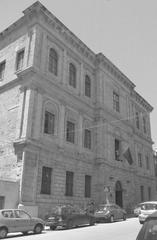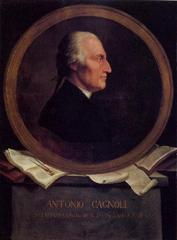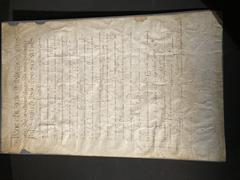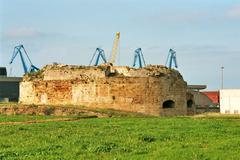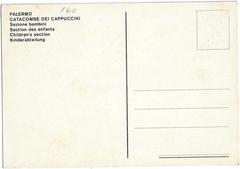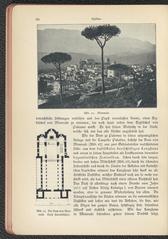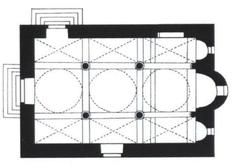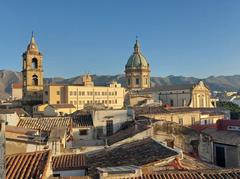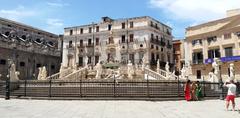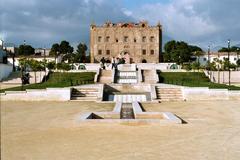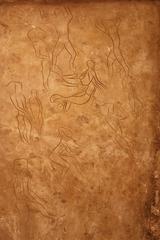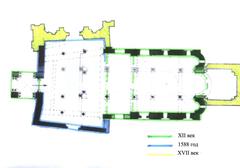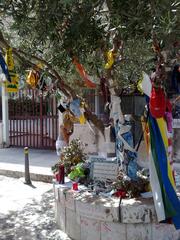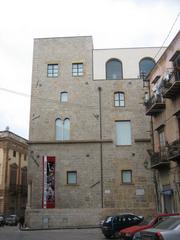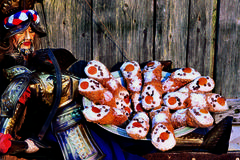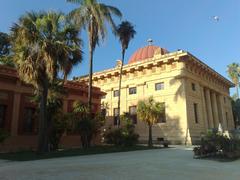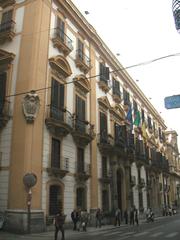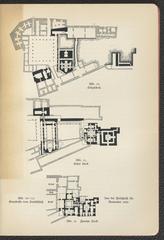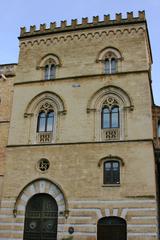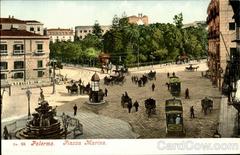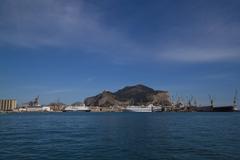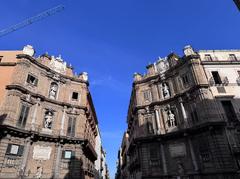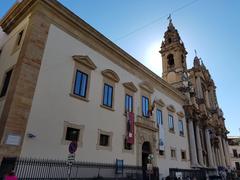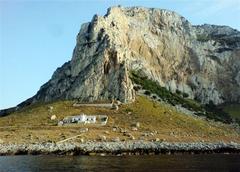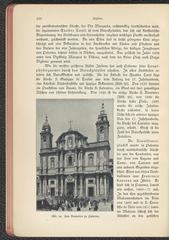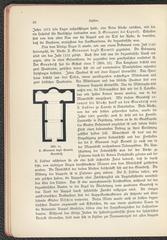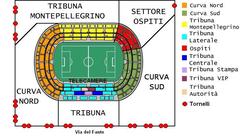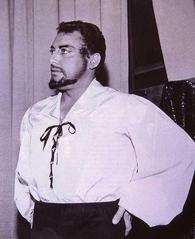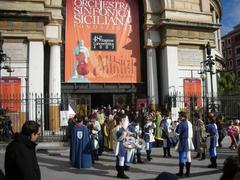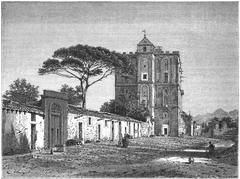Church of the Holy Spirit Palermo: Visiting Hours, Tickets, and Historical Sites Guide
Date: 04/07/2025
Introduction
Nestled in Palermo’s historic Kalsa district, the Church of the Holy Spirit (Chiesa dello Spirito Santo)—often referred to as “Santo Spirito” or “La Magione”—offers a profound window into Sicily’s layered medieval heritage and resilient cultural identity. Founded in the late 12th century under Archbishop Walter of the Mill and supported by King William II of Sicily, the church embodies the celebrated Arab-Norman architectural style, reflecting a convergence of Norman, Arab, and Byzantine influences unique to Sicily. Its historical significance is further elevated as the symbolic birthplace of the Sicilian Vespers uprising in 1282, a pivotal event that reshaped both Sicilian and Mediterranean history (Italy Heaven).
Today, Santo Spirito remains an active religious site and a treasured landmark for visitors interested in history, art, and spirituality. Whether you seek to explore medieval architecture, appreciate Palermo’s religious traditions, or enjoy a moment of reflection, this guide provides practical information on visiting hours, tickets, accessibility, travel tips, and nearby attractions to help you make the most of your Palermo experience. For detailed historical and visitor insights, see Italy Heaven and WeArePalermo.
Table of Contents
- Historical Overview
- Architectural and Artistic Features
- Visiting Information
- Nearby Attractions and Suggested Itinerary
- Events and Religious Services
- Photography and Souvenirs
- Practical Tips and Responsible Tourism
- Frequently Asked Questions (FAQ)
- Conclusion
- References and Further Reading
Historical Overview
Origins and Foundation
The Church of the Holy Spirit was founded between 1173 and 1178 by Walter of the Mill, then Archbishop of Palermo, and funded by King William II. Initially entrusted to Cistercian monks from the Abbey of Sambucina in Calabria, the church was part of a larger monastic complex dedicated to the ideals of simplicity and spiritual contemplation characteristic of the Cistercian order. This era saw the emergence of the Arab-Norman style, blending Norman, Arab, and Byzantine influences into a distinctive Sicilian aesthetic.
Sicilian Vespers and Cultural Significance
Santo Spirito’s most enduring claim to fame is its association with the Sicilian Vespers uprising. On Easter Monday in 1282, a rebellion against French Angevin rule erupted outside the church, sparking a series of events that led to the expulsion of the Angevins from Sicily. This pivotal moment is commemorated annually and remains a symbol of Sicilian resistance and autonomy (Italy Heaven). The church’s central role in this historic event ensures its place as a living emblem of Sicilian identity and resilience.
Architectural and Artistic Features
Exterior Highlights
The church’s exterior presents the hallmark simplicity of Cistercian architecture. Constructed from local sandstone and limestone, its façade is marked by a pointed Gothic portal and a rose window that allows natural light to illuminate the nave. Subtle Arabesque decorative elements recall the multicultural influences at play, while later Baroque interventions—such as the bell towers—testify to its evolving artistic narrative.
Interior Design and Art
Inside, the church is characterized by a coffered wooden ceiling, pointed Norman arches, and minimal ornamentation, all in keeping with Cistercian ideals. The most significant artistic addition is the stucco work by Giacomo Serpotta and his workshop, which depicts scenes from Christ’s life with exceptional delicacy. The main altar and side chapels feature Baroque flourishes and 16th-century liturgical furnishings from the Gaginesque school, creating a dialogue between austere spirituality and later artistic exuberance.
The Cloister and Monastic Complex
Though much of the original monastic complex was lost to urban development, the adjacent cloister remains a tranquil space with medieval frescoes and 14th-century fountains. Its pointed arches and harmonious proportions offer visitors a contemplative retreat, echoing the rhythms of monastic life.
Visiting Information
Location and How to Get There
- Address: Via Magione, 44, 90133 Palermo PA, Italy (Kalsa district)
- On Foot: Easily accessible from Palermo’s historic center and major attractions such as Palermo Cathedral and Ballarò Market.
- Public Transport: Local buses and taxis stop nearby (Via Lincoln and Via Roma).
- By Car: Limited parking; walking is recommended in the historic center due to narrow streets.
Visiting Hours and Ticketing
- Opening Hours: Generally 9:00 AM–1:00 PM and 3:00 PM–6:00 PM, Monday to Saturday. Hours may vary during religious services, holidays, or restoration periods.
- Admission: Free. Donations are encouraged to support ongoing preservation.
- Guided Tours: Available occasionally, especially during peak season or by arrangement; check ahead with local tour operators or the parish office.
Accessibility
- The main entrance has a short flight of steps, and some interior flooring is uneven due to the building’s age.
- Visitors with reduced mobility should contact the church in advance for guidance or assistance.
- Restrooms and wheelchair facilities are not available on-site.
Dress Code and Visitor Etiquette
- Modest attire is required: cover shoulders and knees, remove hats upon entering.
- Silence is expected, especially during services.
- Photography is generally permitted without flash or tripods. Respect signage and avoid taking photos during religious ceremonies.
Facilities and Safety
- No on-site restrooms or cloakroom; public facilities are available in the Kalsa district.
- Bring water, especially in summer; no fountains inside.
- Palermo is generally safe, but exercise standard precautions against pickpockets, especially in tourist areas.
Nearby Attractions and Suggested Itinerary
Within a short walk, you’ll find several of Palermo’s most celebrated historical sites:
- Ballarò Market: Palermo’s oldest street market, ideal for sampling Sicilian street food.
- Palazzo Abatellis: Home to the Regional Gallery of Sicily, with important Gothic-Catalan architecture and art.
- Church of San Cataldo & Martorana: UNESCO-listed churches with unique Arab-Norman mosaics.
- Botanical Garden of Palermo: Offers Mediterranean and exotic flora in a peaceful setting.
Suggested Itinerary: Morning visit to the Church of the Holy Spirit, lunch at Ballarò Market, and an afternoon exploring nearby museums and churches.
Events and Religious Services
- Regular Catholic Masses and special religious celebrations (Easter, Pentecost, the Sicilian Vespers commemoration).
- Visitors are welcome but should avoid disruptions during services.
- Local festivals may include concerts, processions, and cultural events that provide insight into Palermo’s spiritual traditions.
Photography and Souvenirs
- Non-flash photography is permitted except during religious ceremonies.
- No on-site gift shop, but the Kalsa district is home to artisan stores offering religious icons, ceramics, and Palermo-themed souvenirs.
Practical Tips and Responsible Tourism
- Hydration and Sun Protection: Bring water, sunscreen, and a hat, especially in summer.
- Language: Italian is primary; some English is spoken at tourist sites.
- Payments: Carry euros for small purchases and donations; credit cards accepted in most cafes.
- Respect: Greet staff and locals, observe silence, and respect local customs during religious events.
- Seasonal Considerations: Visit in spring or autumn for mild weather and fewer crowds (Avoid Crowds).
Frequently Asked Questions (FAQ)
Q: Are tickets required to visit the Church of the Holy Spirit?
A: No, admission is free. Donations are encouraged.
Q: What are the church’s visiting hours?
A: Generally 9:00 AM–1:00 PM and 3:00 PM–6:00 PM, Monday to Saturday. Check ahead for updates.
Q: Is the church accessible for wheelchair users?
A: The main entrance has steps; accessibility is limited. Contact the church for assistance.
Q: Can I take photographs inside?
A: Yes, non-flash photography is allowed unless otherwise indicated. Please respect signage and ongoing services.
Q: What other Palermo historical sites are nearby?
A: Ballarò Market, Palazzo Abatellis, Church of San Cataldo, Martorana, and the Botanical Garden.
Conclusion
The Church of the Holy Spirit is a must-visit Palermo historical site that beautifully encapsulates Sicily’s multicultural heritage, architectural innovation, and living faith. Its enduring role in the Sicilian Vespers, striking Arab-Norman features, and tranquil cloister invite visitors to step into Palermo’s rich past and vibrant present. With free admission, convenient location, and proximity to other major landmarks, Santo Spirito offers a rewarding and accessible experience for every traveler. Plan your visit today, and enhance your journey with guided tours, cultural events, and responsible tourism practices.
For a richer understanding and up-to-date visitor information, consult trusted guides such as Italy Heaven, GPSmyCity, and WeArePalermo.
Plan your trip today and enhance your Palermo journey! Download the Audiala app for guided tours, updates, and exclusive content on Sicily’s treasures. Follow our social media channels for more travel inspiration and insider tips.
References and Further Reading
- Visiting the Church of the Holy Spirit (Santo Spirito) in Palermo: History, Hours & Tips, 2025
- Exploring the Church of the Holy Spirit Palermo: Visiting Hours, Tickets, and Historical Highlights, 2025
- Church of the Holy Spirit Palermo: Visiting Hours, Tickets & Historical Significance, 2025
- Church of the Holy Spirit Visiting Hours, Tickets, and Guide to Palermo Historical Sites, 2025
- Palermo Historical Religious Buildings Walking Tour, GPSmyCity, 2025
- When is the Best Time to Visit Palermo, Italy?
